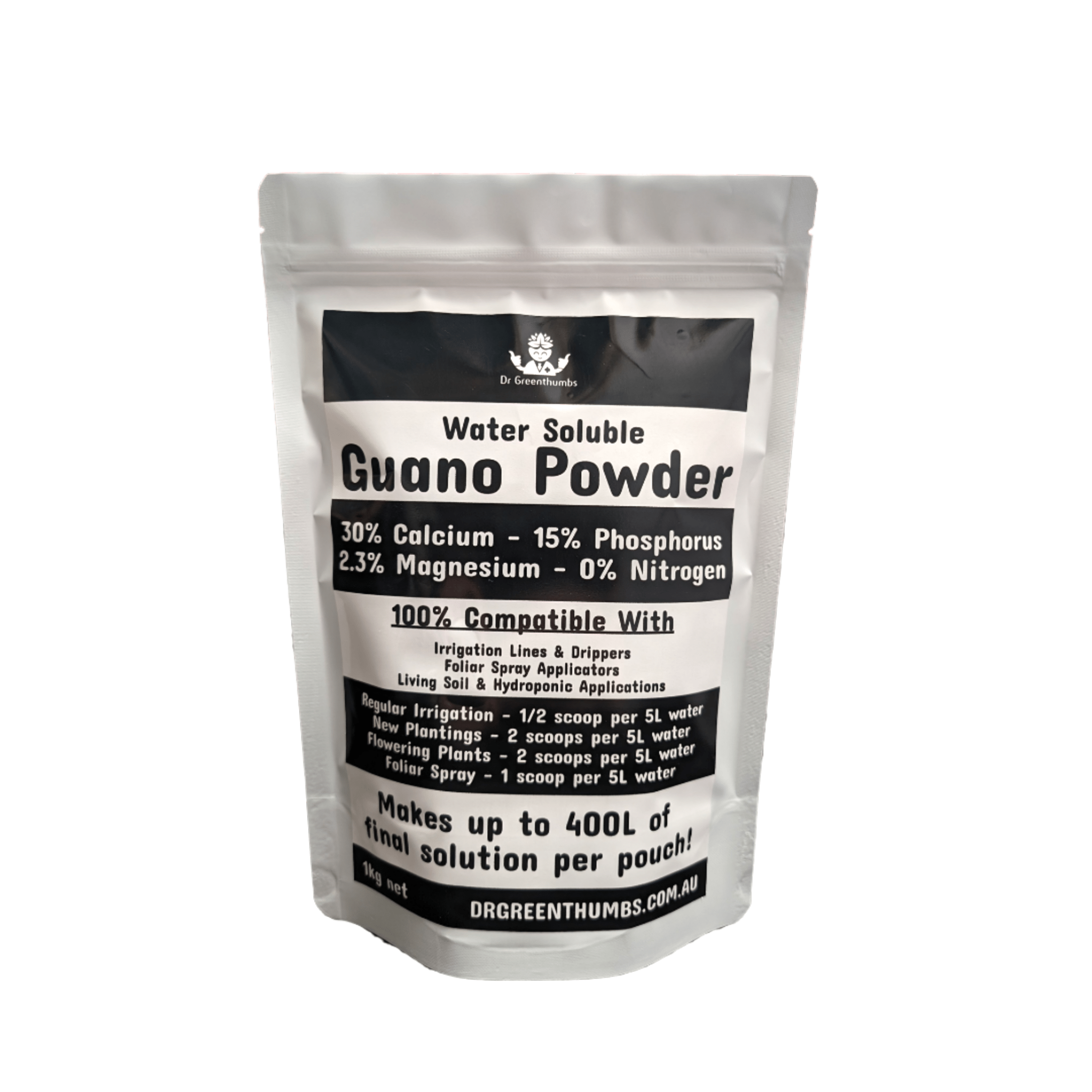Guano Powder is a revolutionary, microbe-friendly choice in fertilization. Unlike typical fertilizers, Guano Powder uniquely combines phosphorus and calcium, essential nutrients often missing in tandem from conventional options. This natural guano-based product stands out, as soluble synthetic phosphorus (P) and calcium (Ca) often clash, making Guano Powder your go-to for harmonious soil enrichment.
Phosphorus, the second most lacking nutrient in soil, is critical for plant metabolism, flowering, and potentially hastens maturity. Plants short on phosphorus show stunted growth. Guano Powder steps in to fill this gap effectively, fostering robust plant development and healthier produce.
Calcium's role is equally pivotal. It not only enhances other nutrient absorption but also nurtures a thriving soil ecosystem. Balanced calcium levels in soil equate to richer, more vibrant plant life. With Guano Powder, you're not just feeding your plants; you're cultivating an environment where they flourish.
Guano Powder is a savior for soils damaged by chemical fertilizers. Its living microbial flora rejuvenates organic matter, boosting microbial activity. This leads to improved nutrient uptake, superior plant health, and optimal soil moisture levels.
Our product is a testament to balance – offering a friable, workable soil structure, ensuring root health and maximum nutrient availability. It counters the harsh effects of magnesium toxicity while safeguarding your crops from other ailments.
How To Use
Regular Irrigation - 1/2 scoop per 5L water
New Plantings - 2 scoops per 5L water
Flowering Plants - 2 scoops per 5L water
Foliar Spray - 1 scoop per 5L water
30% Calcium
15% Phosphorus
2.3% Magnesium
FAQs:
What exactly is Water Soluble Guano?
A micronized, fast-dissolving guano powder that supplies a big hit of phosphorus plus a hefty dose of calcium and a touch of magnesium—designed to be mixed with water for irrigation or foliar use.
What does Water Soluble Guano analyse at?
Calcium ~30%, Phosphorus ~15%, Magnesium ~2.3%. There’s negligible nitrogen or potassium—this product is all about P, Ca (and a little Mg).
What plants benefit most from Water Soluble Guano?
Anything that flowers, fruits or needs strong roots—veg, herbs, ornamentals, fruit trees, and heavy-feeding annuals.
Why would I use guano over standard synthetic P?
You get phosphorus and calcium together in a natural form that plays nicely in the tank and in soil biology. Synthetic P plus calcium often fight each other; this avoids that drama.
Is Water Soluble Guano actually water-soluble or just “fine powder”?
It’s micronized to dissolve rapidly with a quick stir. If you see a few fines, they’ll stay suspended with light agitation when you’re mixing or recirculating.
Will Water Soluble Guano clog drip lines?
Unlikely when mixed properly. Pre-dissolve in a bucket, pour through a fine mesh or paint strainer, keep the tank agitated, and run a standard screen filter on your drip (common 120-mesh/≈130 µm works well). Flush lines after dosing if you’re cautious.
Can I use Water Soluble Guano in hydro or coco?
Yes—great as a phosphorus/calcium supplement in coco or recirculating systems. Pre-dissolve, filter fines, keep gentle agitation, and watch reservoir hygiene like you would with any organic/mineral input.
Recommended rates?
• Regular irrigation: ½ scoop per 5 L water
• New plantings: 2 scoops per 5 L
• Flowering plants: 2 scoops per 5 L
• Foliar spray: 1 scoop per 5 L
What if I don’t have the included scoop?
Use the same ratio by starting small: mix a heaped teaspoon into 5 L, test on one plant, then scale up to match the response you want.
When should I apply Water Soluble Guano during the grow?
Start light at transplant to establish roots, then lean on it through pre-flower and bloom when P and Ca demand spikes.
How often should I re-apply?
Irrigation: weekly to fortnightly is typical. Foliar: 1–2× per week in veg/early bloom if needed. Always start on the low end and adjust.
What’s the best pH for mixing?
Soil/coco feeds do well around 6.0–6.5. Hydroponic recirculating tanks often like 5.8–6.2. Don’t chase perfect—stay in the healthy range and consistent.
Does Water Soluble Guano play nice with microbes and mycorrhizae?
Yep—this is microbe-friendly. Avoid sterilants (peroxide, strong chlorine) in the same tank if you’re trying to keep biology alive.
Can I mix Water Soluble Guano with my usual liquid nutrients?
Yes. Add it after your base nutrient, keep the water moving, and pH last. If you’re stacking lots of calcium additives, back them off a touch to keep things balanced.
Should I brew Water Soluble Guano into a “tea”?
Not needed—this one dissolves straight into water. If you do brew, skip sugars/molasses in foliar mixes and filter well.
Is foliar spraying safe?
Yes—spray at lights-off or early morning/late afternoon. Aim for a fine mist on both leaf surfaces and avoid runoff. Rinse off any overspray on hard surfaces to prevent white film from calcium.
Will Water Soluble Guano leave residue on leaves?
A light dusting can show if you over-apply or spray in full sun. Use a fine mist, correct dilution, and spray at cooler times to minimize spotting.
Can Water Soluble Guano help with blossom end rot or weak stems?
It supplies calcium (a key player for cell walls), which helps reduce Ca-related disorders. It’s not an instant cure—steady, consistent Ca and even watering are what fix those issues.
Does Water Soluble Guano fix purple stems or slow growth?
If phosphorus shortage is part of the problem, it can help. You’ll usually see happier growth tips and stronger flowering once P demand is met.
Is there any nitrogen in Water Soluble Guano?
Effectively none. Keep your base N where it needs to be. This product tops up P/Ca/Mg without pushing leafiness.
Can I use Water Soluble Guano on seedlings and cuttings?
Yes—go very light (quarter strength) and only if there’s a real need. Young plants don’t need much P.
Is Water Soluble Guano okay for edibles and herbs?
Absolutely. It’s a natural mineral source. For foliar on edibles, give leaves a light rinse before harvest if you spray late.
Does Water Soluble Guano change soil pH?
Calcium tends to buffer acidity slightly over time, but this isn’t a replacement for lime. Test soil occasionally and amend as needed.
What water temperature mixes best?
Room-temp or slightly warm water dissolves fastest. Add powder to water (not water to powder), stir, then strain if you’re feeding through fine emitters.
Can I tank-mix with silica or Cal-Mag?
Usually fine. Add silica first (if using), then base nutrients, then this guano, then any remaining additives, and pH last. If your recipe already runs high calcium, reduce overlap.
Any interactions with phosphoric acid pH-down?
You can pH-down with it, just avoid slamming in concentrated acid on top of undissolved powder. Mix thoroughly, then adjust pH slowly.
How long can a mixed solution sit?
Best practice: mix what you’ll use that day. If you must hold it, keep it agitated and use within 24–48 hours. Stagnant tanks invite biofilm.
Does Water Soluble Guano smell?
Barely—more “earthy mineral” than manure. Any whiff fades fast once diluted.
Storage and shelf life?
Keep it sealed, cool and dry. It’s a mineral powder—stored properly, it’s good for years. Break up any clumps before use.
Is Water Soluble Guano certified organic?
It’s a natural guano-derived calcium-phosphate with magnesium. Certification depends on the certifying body and the exact supply batch—if you’re growing to a standard, check your program’s allowed-input list.
Is the Water Soluble Guano bat or seabird guano?
It’s formulated as a micronized guano-phosphate with high calcium. Source may vary by batch; functionally it’s aimed at delivering soluble P and Ca without the usual mixing conflicts.
Will Water Soluble Guano stain walls or floors when foliar spraying?
It can leave a faint white haze where droplets dry. Lay down a drop sheet and wipe up overspray promptly.
Can I use Water Soluble Guano right up to harvest?
For root feeds—yes, but taper as you normally would. For foliar, stop 1–2 weeks before harvest on edible leaves or visible flowers to keep surfaces clean.
Does Water Soluble Guano help “finish” crops faster?
Phosphorus supports energy transfer and maturity. It won’t force a finish, but plants short on P often stall—fixing that keeps them on schedule.
What signs tell me to increase or decrease the dose?
Increase if you see sluggish bud set, dull/blue-green leaves, or slow roots (and your EC is otherwise sensible). Decrease if leaf tips crisp, runoff EC climbs, or you see white residue from over-spraying.
Can I combine Water Soluble Guano with kelp, humics or microbial inoculants?
Great combo. Kelp for stress tolerance, humics/fulvics for chelation, microbes for cycling—just don’t sterilize the tank afterward.
Is Water Soluble Guano safe around pets and kids?
It’s a fertilizer, not food—store securely, don’t inhale dust, and clean up spills. Keep out of reach like any garden input.
Any tips for drip systems specifically?
Pre-dissolve, strain, use a screen filter, and run a short fresh-water flush at the end of the cycle. Inspect emitters now and then—good hygiene prevents headaches.
Can I top-dress Water Soluble Guano dry?
You can, but it shines when dissolved. If top-dressing, water in thoroughly to prevent granules from sitting dry on the surface.
I used Water Soluble Guano and saw “monster flowers” in a few weeks—normal?
Heavier blooms after dialing in P/Ca is exactly what many growers report. Keep the rest of your program (EC, pH, irrigation) consistent to lock those gains in.
What if I think my soil has too much magnesium already?
This formula is mostly Ca and P with only a touch of Mg. Calcium helps balance high-Mg soils—go by plant response and soil tests.
Can I get help building a recipe around Water Soluble Guano?
Sure—start with your base nutrient, add this for targeted P/Ca in veg→bloom, pair with kelp/humics if you like biology-forward growing, and keep notes. If you want a tighter plan, reach out and we’ll help tune it to your medium and water.



